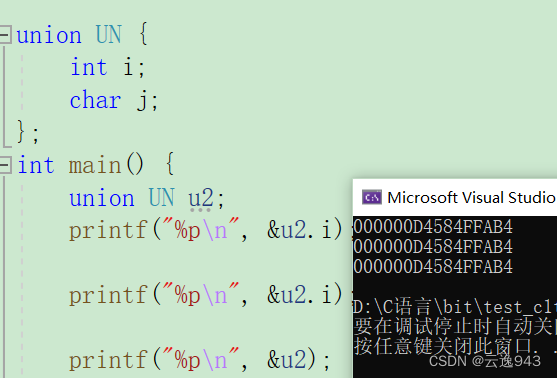当前位置:网站首页>LeetCode1166. Designing File Systems
LeetCode1166. Designing File Systems
2022-08-11 05:46:00 【FussyCat】
leecode题链接:LeetCode1166.设计文件系统
题目描述:
你需要设计一个能提供下面两个函数的文件系统:
create(path, value): 创建一个新的路径,并尽可能将值 value 与路径 path 关联,然后返回 True.如果路径已经存在或者路径的父路径不存在,则返回 False.
get(path): 返回与路径关联的值.如果路径不存在,则返回 -1.
“路径” 是由一个或多个符合下述格式的字符串连接起来形成的:在 / 后跟着一个或多个小写英文字母.
例如 /leetcode 和 /leetcode/problems 都是有效的路径,但空字符串和 / 不是有效的路径.
示例 1:
输入:
[“FileSystem”,“create”,“get”]
[[],["/a",1],["/a"]]
输出:
[null,true,1]
解释:
FileSystem fileSystem = new FileSystem();
fileSystem.create("/a", 1); // 返回 true
fileSystem.get("/a"); // 返回 1
示例 2:
输入:
[“FileSystem”,“create”,“create”,“get”,“create”,“get”]
[[],["/leet",1],["/leet/code",2],["/leet/code"],["/c/d",1],["/c"]]
输出:
[null,true,true,2,false,-1]
解释:
FileSystem fileSystem = new FileSystem();
fileSystem.create("/leet", 1); // 返回 true
fileSystem.create("/leet/code", 2); // 返回 true
fileSystem.get("/leet/code"); // 返回 2
fileSystem.create("/c/d", 1); // 返回 false 因为父路径 “/c” 不存在.
fileSystem.get("/c"); // 返回 -1 因为该路径不存在.
提示:
对两个函数的调用次数加起来小于等于 10^4
2 <= path.length <= 100
1 <= value <= 10^9
解题思路:
Use hash table processing,题解如注释所示.
以下用C语言实现:
#define MAX_PATH_LEN 101
typedef struct {
char keyPath[MAX_PATH_LEN];
int value;
UT_hash_handle hh;
} FileSystem;
FileSystem* fileSystemCreate() {
FileSystem *obj = NULL;
FileSystem* sys = (FileSystem*)malloc(sizeof(FileSystem));
memset(sys, 0, 1 * sizeof(FileSystem));
HASH_ADD_STR(obj, keyPath, sys);
return obj;
}
/* ADD */
bool fileSystemCreatePath(FileSystem* obj, char * path, int value) {
char* startPos = strchr(path, '/'); /* */
char* endPos = strrchr(path, '/');
FileSystem *out = NULL;
HASH_FIND_STR(obj, path, out);
if (out != NULL) {
/* 路径存在,return error */
return false;
}
if (startPos != endPos) {
/* 说明pathis the subpath */
char fatherPath[MAX_PATH_LEN] = {
0};
strncpy(fatherPath, path, endPos - startPos); /* Take out the parent path */
HASH_FIND_STR(obj, fatherPath, out);
if (out == NULL) {
/* 父路径不存在,return error */
return false;
}
}
/* pathis the parent path and does not exist;pathchild path and its parent path exists,则创建 */
FileSystem *newSys = (FileSystem *)malloc(1 * sizeof(FileSystem));
strcpy(newSys->keyPath, path);
newSys->value = value;
HASH_ADD_STR(obj, keyPath, newSys);
return true;
}
int fileSystemGet(FileSystem* obj, char * path) {
FileSystem *out = NULL;
HASH_FIND_STR(obj, path, out);
if (out == NULL) {
/* 不存在,returns an error */
return -1;
}
return out->value;
}
void fileSystemFree(FileSystem* obj) {
FileSystem *cur = NULL;
FileSystem *tmp = NULL;
HASH_ITER(hh, obj, cur, tmp) {
HASH_DEL(obj, cur);
free(cur);
}
return;
}
解题总结:
A few basic macros and steps that will use hashing are required
0、定义
typedef struct {
char keyPath[MAX_PATH_LEN]; /* key */
int value; /* value */
UT_hash_handle hh; /* Hash table handle */
} FileSystem;
1、初始化
定义一个头指针 FileSystem *head = NULL;
But in this case directly fileSystemCreate() 函数中定义,and allocate a temporary empty table,加入哈希表中.
2、表示增加,There are related macros:
字符串:#define HASH_ADD_STR(head,strfield,add)
整型: #define HASH_ADD_INT(head,intfield,add)
指针: #define HASH_ADD_PTR(head,ptrfield,add)
本例中,哈希的keyis a string pathkeyPath,故用 HASH_ADD_STR,且strfield即为keyPath,add应为 FileSystem add,add是一对(keyPath, value)键值.
HASH_ADD_STR(obj, keyPath, sys); / obj为头指针,keyPath为key域,sys为add键值对 */
注意,add需要malloc.
3、表示查找,The associated macro is :
字符串:#define HASH_FIND_STR(head,findstr,out)
整型: #define HASH_FIND_INT(head,findint,out)
指针: #define HASH_FIND_PTR(head,findptr,out)
本例中,函数入参pathis the path to address matching,findstr即为path,outThe argument is the result of the match,If it is empty, there is no match;A non-empty description matched.
HASH_FIND_STR(obj, keyPath, out); /* obj为头指针,keyPath为key域,outFor finding result key-value pairs */
4、表示删除,The relevant macro is :
#define HASH_DEL(head,delptr)
A macro that is used in conjunction with traversal:
#define HASH_ITER(hh,head,el,tmp)
如本例中,
FileSystem *cur = NULL;
FileSystem *tmp = NULL;
HASH_ITER(hh, obj, cur, tmp) {
HASH_DEL(obj, cur);
free(cur);
}
5、表示替换,There are related macros(本例没有用到):
字符串:#define HASH_REPLACE_STR(head,strfield,add,replaced)
整型: #define HASH_REPLACE_INT(head,intfield,add,replaced)
指针: #define HASH_REPLACE_PTR(head,ptrfield,add,replaced)
边栏推荐
- task02 fashion-mnist分类实战
- Solidrun hummingboard制作SD卡
- C语言文件操作——数据文件类型、文件判断、文件缓冲区详解
- (2) Construction of a real-time performance monitoring platform (Grafana+Prometheus+Jmeter)
- pytorch基础之 pytorch 模型开发模板
- Flask framework learning: trailing slashes for routes
- C语言——文件操作详解(1)
- 【记录】innerHeight?clientHeight?offsetHeight?scrollTop?screenTop?.....一堆高度傻傻分不清
- 性能效率测试
- imx6 yocto编译备忘
猜你喜欢
随机推荐
LeetCode43.字符串相乘 (大数相乘可用此方法)
第13章类继承
2021研究生数学建模D题,BP神经网络和卷积神经网络解题代码(基于pytorch)
Flask framework learning: trailing slashes for routes
开炮,开炮
Visual Studio上一些Error的解决方案
flask框架学习:debug与配置项
面试宝典一: code题目记录
【转载】如何理解数据集中【训练集】、【验证集】和【测试集】
【C语言从初阶到进阶】第一篇 初始C语言(一)
DS220702-0707作业
【win10+cuda7.5+cudnn6.0安装caffe②】安装Visual Studio 2013和caffe
C语言——逆序输出字符串的函数实现
简单做份西红柿炒蛋778
第10章 对象和类-2
task06 PyTorch生态
基于 TF-IDF 文本匹配实战详细教程 数据+代码 可直接运行
LeetCode1166.设计文件系统
C语言版——通讯录进阶(文件版本)
第8章 函数探幽 -1









